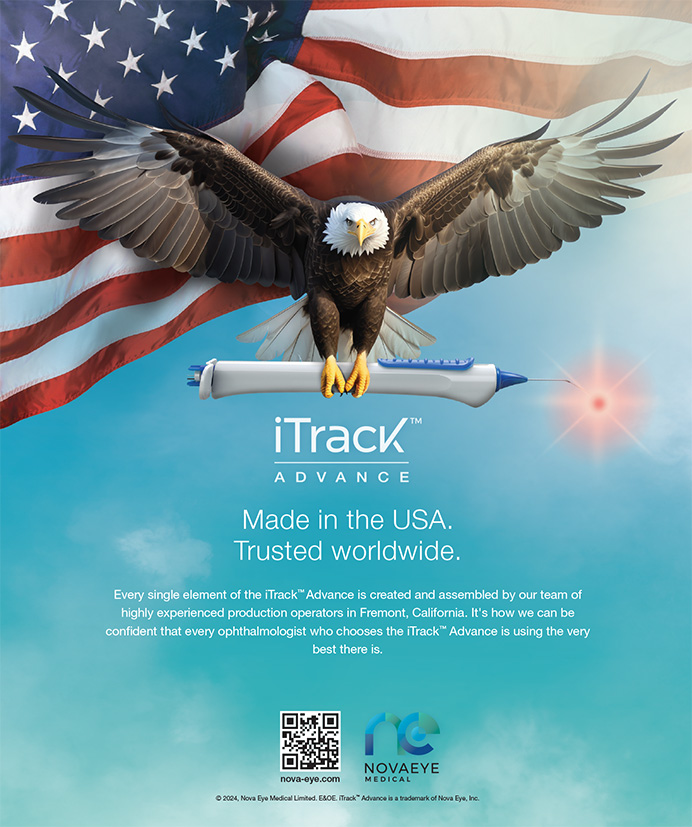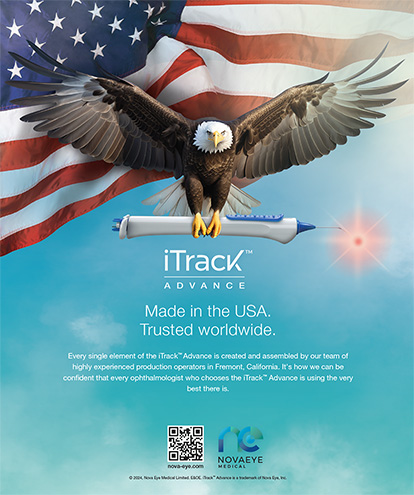When IOLs were first introduced, the only lens material used was polymethylmethacrylate (PMMA). Any material differences were largely irrelevant until glass IOLs came along. Glass had some adherents until it became clear that Nd:YAG laser capsulotomy could shatter this material in the eye, and the product disappeared almost overnight.1 The introduction of foldable IOLs (first made of silicone, followed by hydrophobic and hydrophilic acrylic) rendered the issue of material impact important. Early on, the general feeling among ophthalmologists was that materials were extremely important, and conclusions were readily drawn regarding perceived differences. By and large, it was taken as a fact that silicone IOLs were more inflammatory in the eye and that they induced much more posterior and anterior capsular opacification than hydrophobic acrylic lenses (Figure 1).
We surgeons now recognize that the physical properties of these early IOLs were also important to how they behaved in the eye. The best example—and the principle that is now best understood—relates to the truncated edge of the optic, which can act as a barrier against the migration of lens epithelial cells and thus decrease the development of posterior capsular opacification (PCO).2,3 This observation suggested that PCO prevention was not necessarily related to the hydrophobic acrylic material but could just as easily be the result of this mechanical difference in the edge of the optic. Furthermore, although many studies showed an increase in inflammatory signs such as giant cell deposition with early silicone IOLs,4 this tendency decreased with later generations of these lenses.5 Similarly, anterior capsular contraction and opacification appeared to be related to silicone lenses, but newer versions of these IOLs have not necessarily shared this characteristic.6
WHAT WE HAVE LEARNED OVER TIME
First, an IOL is a package deal. In other words, a lens’ physical characteristics and material are important to how it functions in the eye. It is necessary (but often difficult) to differentiate between IOL material and the physical characteristics of the lens.
Second, although we surgeons like to simplify our categorization of lenses, we now perceive clear differences within each material category. For instance, one IOL in a given category is not necessarily going to act like another in terms of inflammatory signs or capsular contracture. As another example, the propensity for glistenings in the optical material differs greatly among lenses that are categorized as hydrophobic acrylic.7 In addition, although the problem of calcification has largely been associated with hydrophilic acrylic IOLs, some models have been on the market for quite awhile with little to no problems reported to date. We need to be very careful about lumping lenses together in a single category.
Third, as time goes on, I hope that we will come to understand the best characteristics of each material as well as the best physical characteristics of the available lenses so that we may improve the overall quality of IOLs in the future.
DOCUMENTED MATERIAL DIFFERENCES TODAY
Silicone
If their optics have a truncated edge, silicone IOLs can have an excellent—possibly a superior—PCO-prevention profile.6 Lenses made of some of the latest silicone materials have been associated with no more inflammation than hydrophobic acrylic IOLs and no greater rate of anterior capsular contracture.5,6 Most likely due to their lower refractive index, silicone lenses seem to be more forgiving of pseudophakic dysphotopsia than many acrylic IOLs.7
A problem associated exclusively with silicone IOLs is that silicone oil present in the eye tends to obscure our view, which continues to make the use of these lenses inadvisable for some patients.8 Silicone IOLs have also been uniquely associated with calcification in any eye with asteroid hyalosis (Figure 2), so this uncommon problem is another relative contraindication for these lenses.9
Hydrophobic Acrylic
In the United States at least, hydrophobic acrylic IOLs are by far the most commonly used today. When designed with a truncated optical edge, these lenses are highly resistant to PCO.6
Hydrophobic acrylic IOLs tend to be brittle, and inappropriate handling can damage their surface or even crack the optic. Contemporary insertion devices, however, have essentially eliminated these problems. Some of the IOLs in this category have exhibited a propensity for the formation of glistenings inside the lens optic.10 Hydrophobic acrylic IOLs have also generally been associated with more pseudophakic dysphotopsia than lenses made of other materials, but this problem may be due to a higher refractive index and a flatter anterior curvature as well as to an untreated, truncated optical edge.
Hydrophobic Acrylic
In the United States at least, hydrophobic acrylic IOLs are by far the most commonly used today. When designed with a truncated optical edge, these lenses are highly resistant to PCO.6
Hydrophobic acrylic IOLs tend to be brittle, and inappropriate handling can damage their surface or even crack the optic. Contemporary insertion devices, however, have essentially eliminated these problems. Some of the IOLs in this category have exhibited a propensity for the formation of glistenings inside the lens optic.10 Hydrophobic acrylic IOLs have also generally been associated with more pseudophakic dysphotopsia than lenses made of other materials, but this problem may be due to a higher refractive index and a flatter anterior curvature as well as to an untreated, truncated optical edge.
Hydrophilic Acrylic
These lenses certainly allow us the best view in eyes containing silicone oil.8 Hydrophilic acrylic is probably also the most biocompatible of all IOL materials—an important consideration for cataract surgery in eyes with chronic uveitis, for example.11
Truncated optical edges greatly limit PCO formation, but the problem still seems to be more common with hydrophilic acrylic IOLs than with lenses made of other materials.12 Although hydrophilic acrylic lenses have been plagued with calcification,13 the latest generation of these IOLs is largely (perhaps completely) immune to this problem. Further study and experience are necessary to confirm this observation.
PMMA
Rarely used today in the United States, PMMA lenses are common elsewhere in the world. These lenses have an excellent long-term track record and, when designed with a truncated optical edge, are very protective against PCO.
Some injection-molded PMMA lenses develop severe glistenings.14 By and large, however, this IOL material is well accepted. Its main downside is the requirement for a large incision, because the material is not foldable.
CONCLUSION
We are still learning about IOL material. We must do a better job, however, of differentiating the physical characteristics of a lens from the effects of its material. We also should not assume that a given lens will behave in the same way as others in the same material category.
Randall J. Olson, MD, is chairman of the Department of Ophthalmology and Visual Sciences and CEO of the John A. Moran Eye Center at the University of Utah School of Medicine in Salt Lake City. Dr. Olson may be reached at (801) 585-6622; randallj.olson@hsc.utah.edu.
- Fritch C.Nd-YAG laser damage to glass intraocular lens.Ann Ophthalmol.1984;16:1177.
- Nishi O,Yamamoto N,Nishi K,Nishi Y.Contact inhibition of migrating lens epithelial cells at the capsular bend created by a sharp-edged intraocular lens after cataract surgery.J Cataract Refract Surg.2007;33:1065-1070.
- Nishi O,Nishi K,Osakabe Y.Effect of intraocular lenses on preventing posterior capsular opacification:design vs material.J Cataract Refract Surg.2004;30:2120-2126.
- Hollick E,Spalton D,Ursell P,et al.Biocompatibility of poly(methyl methacrylate),silicone,and AcrySof intraocular lenses: randomized comparison of the cellular reaction on the anterior lens surface.J Cataract Refract Surg.1998;24:361-366.
- Samuelson T,Chu Y,Krieger R.Evaluation of giant cell deposits on foldable intraocular lenses after combined cataract and glaucoma surgery.J Cataract Refract Surg.2000;26:817-823.
- Vock L,Crnej A,Findl O,et al.Posterior opacification in silicone and hydrophobic acrylic intraocular lenses with sharp-edged optics six years after surgery.Am J Ophthalmol.2009;147:683-690.
- Daynes T,Spencer TS,Doan K,et al.Three-year clinical comparison of 3-piece AcrySof and SI-40 silicone intraocular lenses.J Cataract Refract Surg.2002;28:1124-1129.
- Apple D,Federman T,Krolicki J,et al.Irreversible silicone oil adhesion to silicone intraocular lenses:a clinicopathological analysis.Ophthalmology.1996;103:1555-1561.
- Foot L,Werner L,Gills J,et al.Surface calcification of silicone plate intraocular lenses in patients with asteroid hyalosis.Am J Ophthalmol.2004;137:979-987.
- Gregori N,Spencer T,Mamalis N,Olson R.In vitro comparison of glistening formation among hydrophobic acrylic intraocular lenses. J Cataract Refract Surg.2002;28:1262-1268.
- Abela-Formanek C,Amon M,Schauersberger J,et al.Uveal and capsular biocompatibility of two foldable acrylic lenses in patients with uveitis or pseudoexfoliation syndrome. J Cataract Refract Surg.2002;28:1160-1172.
- Hollick E,Spalton D,Ursell P,et al.Posterior opacification with hydrogel,polymethylmethacrylate,and silicone intraocular lenses:two year results of a randomized prospective trial.Am J Ophthalmol.2000;129:577-584.
- Kleinman G,Mamalis N,Apple D,Assia E.Opacification of the Acryl C 160 hydrophilic acrylic intraocular lens. J Cataract Refract Surg.2006;32:367-368.
- Wilkins E,Olson R.Glistening with long-term follow-up of the Surgidev B20/20 polymethylmethacrylate intraocular lens.Am J Ophthalmol.2001;132:783-785.


